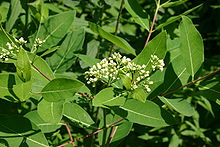- Apocynum cannabinum
-
Apocynum cannabinum Apocynum cannabinum in flower Scientific classification Kingdom: Plantae Division: Magnoliophyta Class: Magnoliopsida Order: Gentianales Family: Apocynaceae Genus: Apocynum Species: A. cannabinum Binomial name Apocynum cannabinum
L.Synonyms - A. sibiricum Jacq. 1777
- A. canadense Shecut 1806
- A. pubescens Mitch. ex R.Br. 1809
- A. purpureum Tausch 1836
- Forsteronia pavonii A.DC 1844
- A. album Greene 1897
- A. nemorale G.S.Mill. 1900
- A. oblongum Greene 1902
- A. salignum Greene 1902
- A. cordigerum Greene 1911
- A. arenarium Greene 1912
- A. bebbianum Greene 1912
- A. bolanderi Greene 1912
- A. cervinum Greene 1912
- A. densiflorum Greene 1912
- A. dictyotum Greene 1912
- A. estellinum Greene 1912
- A. farwellii Greene 1912
- A. isophyllum Greene 1912
- A. subuligerum Greene 1912
- A. suksdorfii Greene 1912
- A. thermale Greene 1912
- A. greeneanum Bég. & Beloserky 1913
- A. cuspidatum Greene ex Bég. & Belosersky 1913
- A. carolinii Nieuwl. 1913
- A. cinereum Nieuwl. 1913
- A. tomentulosum Nieuwl. 1913
- A. angustifolium Wooton 1913
- Cynopaema cannabinum (L.) Lunell 1916
- ...
Apocynum cannabinum (Dogbane, Amy Root, Hemp Dogbane, Indian Hemp, Rheumatism Root, or Wild Cotton) is a perennial herbaceous plant that grows throughout much of North America - in the southern half of Canada and throughout the United States. It is a poisonous plant: Apocynum means "poisonous to dogs". All parts of the plant are poisonous and can cause cardiac arrest if ingested. The cannabinum in the scientific name and the common names Hemp Dogbane and Indian Hemp refer to its similarity to Cannabis as a fiber plant (see Hemp), rather than as a source of a psychoactive drug (see Cannabis (drug))
Although dogbane is poisonous to livestock, it likely got its name from its resemblance to a European species of the same name.[1]
Contents
Distribution and habitat
Apocynum cannabinum grows in open wooded areas, ditches, and hillsides, and prefers moist places.
Description
Apocynum cannabinum grows up to 2 meters/6 feet tall. The stems are reddish and contain a milky latex capable of causing skin blisters. The leaves are opposite, simple broad lanceolate, 7–15 cm long and 3–5 cm broad, entire, and smooth on top with white hairs on the underside. The flowers are produced in mid summer, with large sepals, and a five-lobed white corolla.
Invasive species
In gardens it can be invasive, growing from spreading roots. When growing among corn, Apocynum cannabinum can reduce yields by up to 10% and when growing among soybeans, by up to 40%. It can be controlled through mechanical means, although it is difficult to control with herbicides.
Uses
Phytoremediation
Apocynum cannabinum is a phytoremediation plant, a hyperaccumulator used to sequester lead in its biomass.
Fiber
Apocynum cannabinum was used as a source of fiber by Native Americans, to make hunting nets, fishing lines, clothing, and twine.[1] It is called qéemu [qǽːmu] in Nez Perce and [taxʷɨ́s] in Sahaptin.
Medicinal
It is also used in herbal medicine to treat syphilis, rheumatism, intestinal worms, fever, asthma, and dysentery. Although the toxins from the plant can cause nausea and catharsis, it has also been used for slowing the pulse.
See also
References
- ^ a b Charles Bixler Heiser (2003). Weeds in my garden: observations on some misunderstood plants. Portland, Oregon: Timber Press. p. 50. ISBN 0881925624. http://books.google.com.au/books?id=nN1ohECdSC8C&pg=PA50&dq=Apocynaceae+dogbane&hl=en&ei=7IstTcXuKImuuQPtyPXECQ&sa=X&oi=book_result&ct=result&resnum=1&ved=0CCUQ6AEwAA#v=onepage&q=Apocynaceae%20dogbane&f=false.
- Blanchan, Neltje (2002). Wild Flowers: An Aid to Knowledge of our Wild Flowers and their Insect Visitors. Project Gutenberg Literary Archive Foundation.
- A. Davis, K. Renner, C. Sprague, L. Dyer, D. Mutch (2005). Integrated Weed Management. MSU.
External links

This Apocynaceae article is a stub. You can help Wikipedia by expanding it.

